JEEP GRAND CHEROKEE 2021 Owner handbook (in English)
Manufacturer: JEEP, Model Year: 2021, Model line: GRAND CHEROKEE, Model: JEEP GRAND CHEROKEE 2021Pages: 378, PDF Size: 6.88 MB
Page 281 of 378
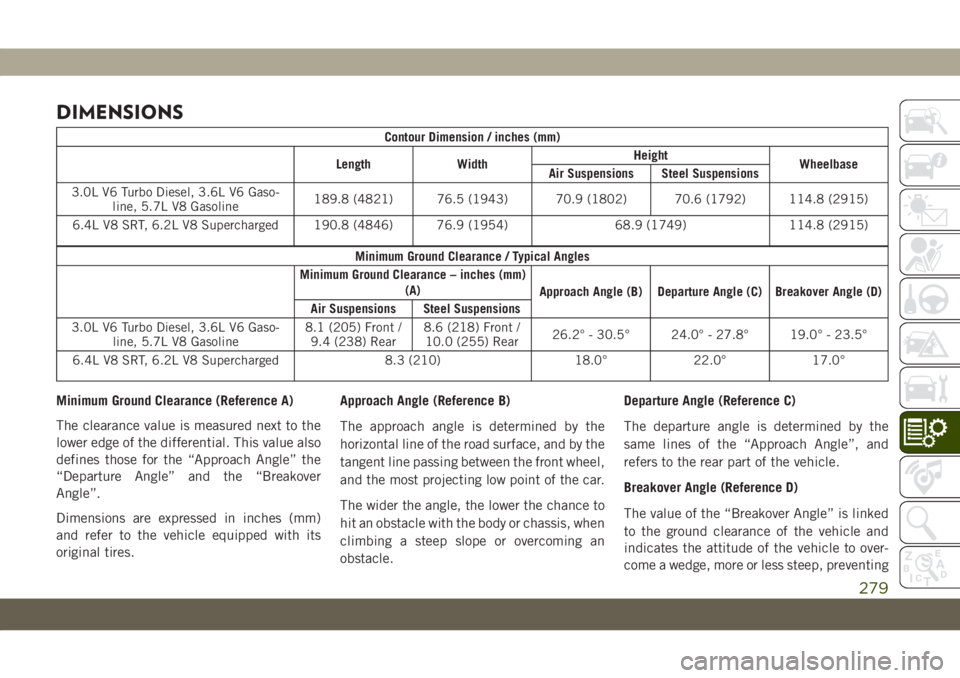
DIMENSIONS
Contour Dimension / inches (mm)
Length WidthHeight
Wheelbase
Air Suspensions Steel Suspensions
3.0L V6 Turbo Diesel, 3.6L V6 Gaso-
line, 5.7L V8 Gasoline189.8 (4821) 76.5 (1943) 70.9 (1802) 70.6 (1792) 114.8 (2915)
6.4L V8 SRT, 6.2L V8 Supercharged 190.8 (4846) 76.9 (1954) 68.9 (1749) 114.8 (2915)
Minimum Ground Clearance / Typical Angles
Minimum Ground Clearance – inches (mm)
(A)
Approach Angle (B) Departure Angle (C) Breakover Angle (D)
Air Suspensions Steel Suspensions
3.0L V6 Turbo Diesel, 3.6L V6 Gaso-
line, 5.7L V8 Gasoline8.1 (205) Front /
9.4 (238) Rear8.6 (218) Front /
10.0 (255) Rear26.2° - 30.5° 24.0° - 27.8° 19.0° - 23.5°
6.4L V8 SRT, 6.2L V8 Supercharged 8.3 (210) 18.0° 22.0° 17.0°
Minimum Ground Clearance (Reference A)
The clearance value is measured next to the
lower edge of the differential. This value also
defines those for the “Approach Angle” the
“Departure Angle” and the “Breakover
Angle”.
Dimensions are expressed in inches (mm)
and refer to the vehicle equipped with its
original tires.Approach Angle (Reference B)
The approach angle is determined by the
horizontal line of the road surface, and by the
tangent line passing between the front wheel,
and the most projecting low point of the car.
The wider the angle, the lower the chance to
hit an obstacle with the body or chassis, when
climbing a steep slope or overcoming an
obstacle.Departure Angle (Reference C)
The departure angle is determined by the
same lines of the “Approach Angle”, and
refers to the rear part of the vehicle.
Breakover Angle (Reference D)
The value of the “Breakover Angle” is linked
to the ground clearance of the vehicle and
indicates the attitude of the vehicle to over-
come a wedge, more or less steep, preventing
279
Page 282 of 378
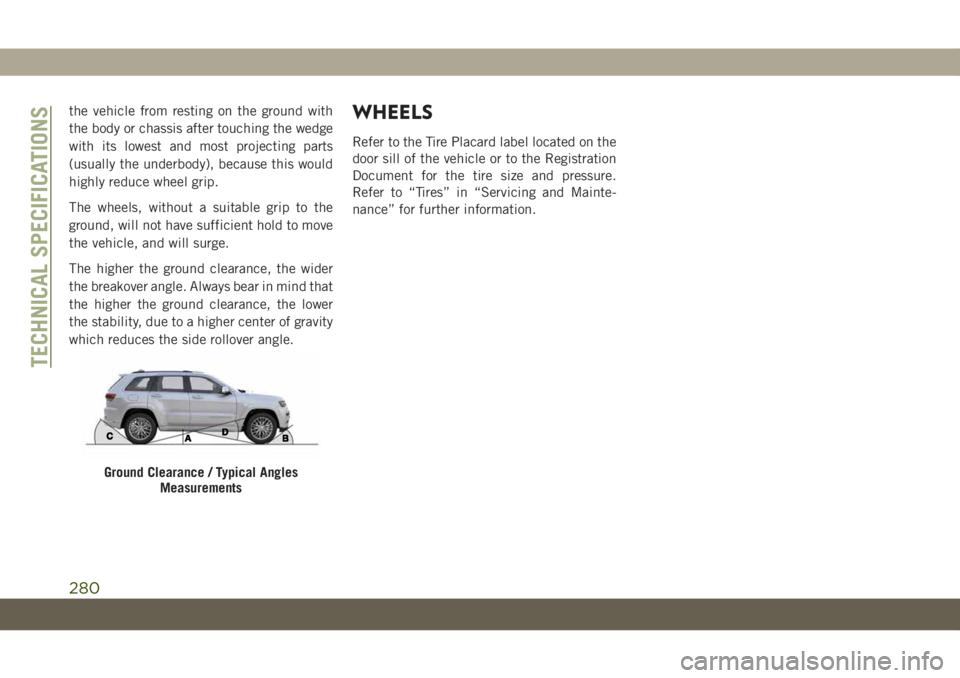
the vehicle from resting on the ground with
the body or chassis after touching the wedge
with its lowest and most projecting parts
(usually the underbody), because this would
highly reduce wheel grip.
The wheels, without a suitable grip to the
ground, will not have sufficient hold to move
the vehicle, and will surge.
The higher the ground clearance, the wider
the breakover angle. Always bear in mind that
the higher the ground clearance, the lower
the stability, due to a higher center of gravity
which reduces the side rollover angle.WHEELS
Refer to the Tire Placard label located on the
door sill of the vehicle or to the Registration
Document for the tire size and pressure.
Refer to “Tires” in “Servicing and Mainte-
nance” for further information.
Ground Clearance / Typical Angles
Measurements
TECHNICAL SPECIFICATIONS
280
Page 283 of 378
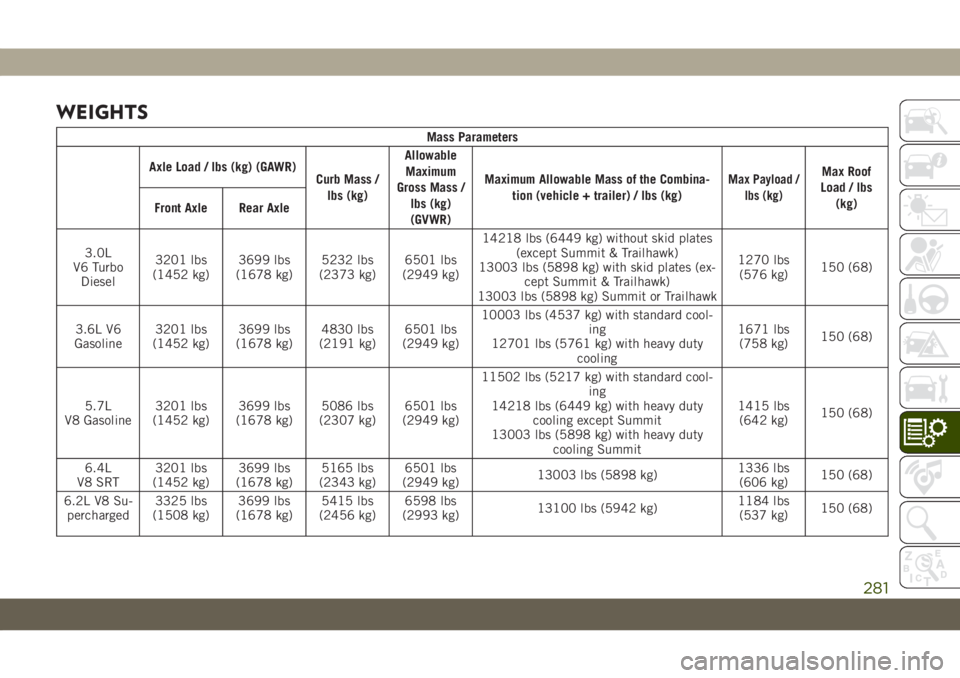
WEIGHTS
Mass Parameters
Axle Load / lbs (kg) (GAWR)
Curb Mass /
lbs (kg)Allowable
Maximum
Gross Mass /
lbs (kg)
(GVWR)Maximum Allowable Mass of the Combina-
tion (vehicle + trailer) / lbs (kg)M
ax Payload /
lbs (kg)Max Roof
Load / lbs
(kg)
Front Axle Rear Axle
3.0L
V6 Turbo
Diesel3201 lbs
(1452 kg)3699 lbs
(1678 kg)5232 lbs
(2373 kg)6501 lbs
(2949 kg)14218 lbs (6449 kg) without skid plates
(except Summit & Trailhawk)
13003 lbs (5898 kg) with skid plates (ex-
cept Summit & Trailhawk)
13003 lbs (5898 kg) Summit or Trailhawk1270 lbs
(576 kg)150 (68)
3.6L V6
Gasoline3201 lbs
(1452 kg)3699 lbs
(1678 kg)4830 lbs
(2191 kg)6501 lbs
(2949 kg)10003 lbs (4537 kg) with standard cool-
ing
12701 lbs (5761 kg) with heavy duty
cooling1671 lbs
(758 kg)150 (68)
5.7L
V8 Gasoline3201 lbs
(1452 kg)3699 lbs
(1678 kg)5086 lbs
(2307 kg)6501 lbs
(2949 kg)11502 lbs (5217 kg) with standard cool-
ing
14218 lbs (6449 kg) with heavy duty
cooling except Summit
13003 lbs (5898 kg) with heavy duty
cooling Summit1415 lbs
(642 kg)150 (68)
6.4L
V8 SRT3201 lbs
(1452 kg)3699 lbs
(1678 kg)5165 lbs
(2343 kg)6501 lbs
(2949 kg)13003 lbs (5898 kg)1336 lbs
(606 kg)150 (68)
6.2L V8 Su-
percharged3325 lbs
(1508 kg)3699 lbs
(1678 kg)5415 lbs
(2456 kg)6598 lbs
(2993 kg)13100 lbs (5942 kg)1184 lbs
(537 kg)150 (68)
281
Page 284 of 378
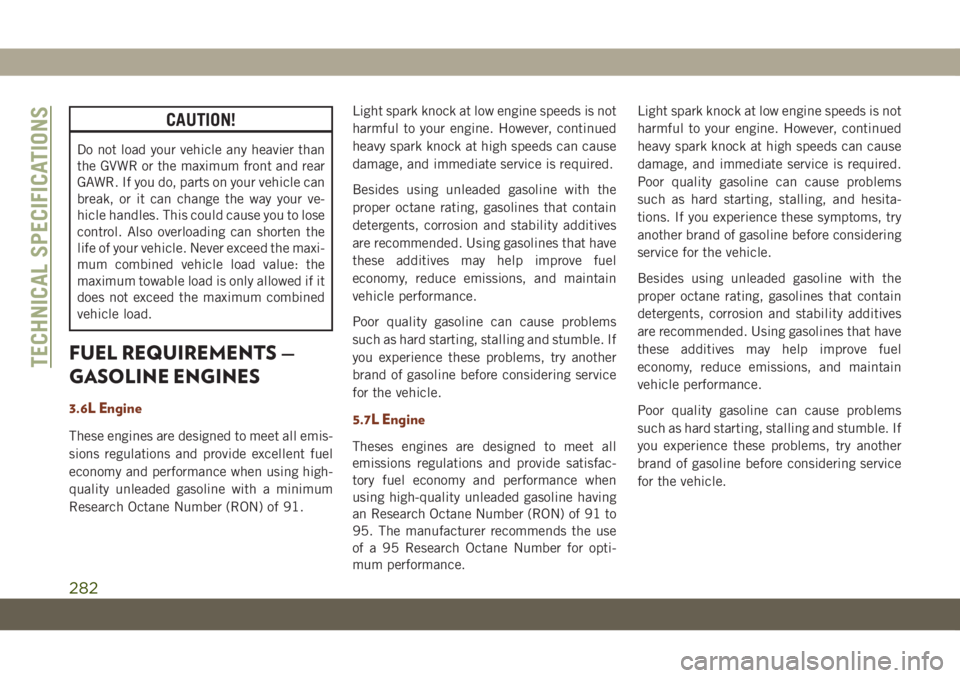
CAUTION!
Do not load your vehicle any heavier than
the GVWR or the maximum front and rear
GAWR. If you do, parts on your vehicle can
break, or it can change the way your ve-
hicle handles. This could cause you to lose
control. Also overloading can shorten the
life of your vehicle. Never exceed the maxi-
mum combined vehicle load value: the
maximum towable load is only allowed if it
does not exceed the maximum combined
vehicle load.
FUEL REQUIREMENTS —
GASOLINE ENGINES
3.6L Engine
These engines are designed to meet all emis-
sions regulations and provide excellent fuel
economy and performance when using high-
quality unleaded gasoline with a minimum
Research Octane Number (RON) of 91.Light spark knock at low engine speeds is not
harmful to your engine. However, continued
heavy spark knock at high speeds can cause
damage, and immediate service is required.
Besides using unleaded gasoline with the
proper octane rating, gasolines that contain
detergents, corrosion and stability additives
are recommended. Using gasolines that have
these additives may help improve fuel
economy, reduce emissions, and maintain
vehicle performance.
Poor quality gasoline can cause problems
such as hard starting, stalling and stumble. If
you experience these problems, try another
brand of gasoline before considering service
for the vehicle.
5.7L Engine
Theses engines are designed to meet all
emissions regulations and provide satisfac-
tory fuel economy and performance when
using high-quality unleaded gasoline having
an Research Octane Number (RON) of 91 to
95. The manufacturer recommends the use
of a 95 Research Octane Number for opti-
mum performance.Light spark knock at low engine speeds is not
harmful to your engine. However, continued
heavy spark knock at high speeds can cause
damage, and immediate service is required.
Poor quality gasoline can cause problems
such as hard starting, stalling, and hesita-
tions. If you experience these symptoms, try
another brand of gasoline before considering
service for the vehicle.
Besides using unleaded gasoline with the
proper octane rating, gasolines that contain
detergents, corrosion and stability additives
are recommended. Using gasolines that have
these additives may help improve fuel
economy, reduce emissions, and maintain
vehicle performance.
Poor quality gasoline can cause problems
such as hard starting, stalling and stumble. If
you experience these problems, try another
brand of gasoline before considering service
for the vehicle.
TECHNICAL SPECIFICATIONS
282
Page 285 of 378
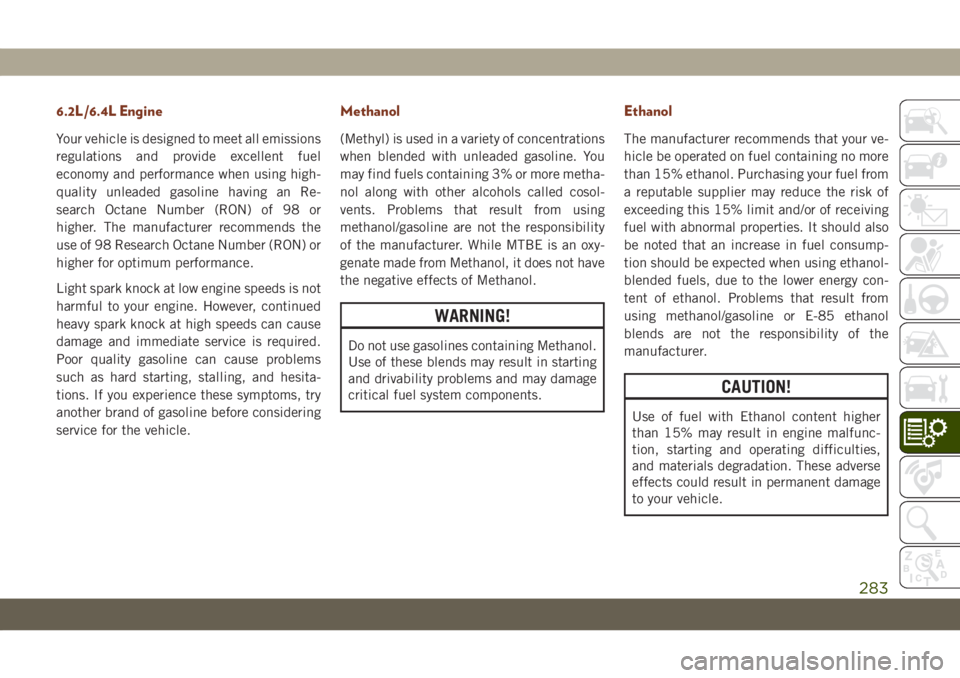
6.2L/6.4L Engine
Your vehicle is designed to meet all emissions
regulations and provide excellent fuel
economy and performance when using high-
quality unleaded gasoline having an Re-
search Octane Number (RON) of 98 or
higher. The manufacturer recommends the
use of 98 Research Octane Number (RON) or
higher for optimum performance.
Light spark knock at low engine speeds is not
harmful to your engine. However, continued
heavy spark knock at high speeds can cause
damage and immediate service is required.
Poor quality gasoline can cause problems
such as hard starting, stalling, and hesita-
tions. If you experience these symptoms, try
another brand of gasoline before considering
service for the vehicle.
Methanol
(Methyl) is used in a variety of concentrations
when blended with unleaded gasoline. You
may find fuels containing 3% or more metha-
nol along with other alcohols called cosol-
vents. Problems that result from using
methanol/gasoline are not the responsibility
of the manufacturer. While MTBE is an oxy-
genate made from Methanol, it does not have
the negative effects of Methanol.
WARNING!
Do not use gasolines containing Methanol.
Use of these blends may result in starting
and drivability problems and may damage
critical fuel system components.
Ethanol
The manufacturer recommends that your ve-
hicle be operated on fuel containing no more
than 15% ethanol. Purchasing your fuel from
a reputable supplier may reduce the risk of
exceeding this 15% limit and/or of receiving
fuel with abnormal properties. It should also
be noted that an increase in fuel consump-
tion should be expected when using ethanol-
blended fuels, due to the lower energy con-
tent of ethanol. Problems that result from
using methanol/gasoline or E-85 ethanol
blends are not the responsibility of the
manufacturer.
CAUTION!
Use of fuel with Ethanol content higher
than 15% may result in engine malfunc-
tion, starting and operating difficulties,
and materials degradation. These adverse
effects could result in permanent damage
to your vehicle.
283
Page 286 of 378
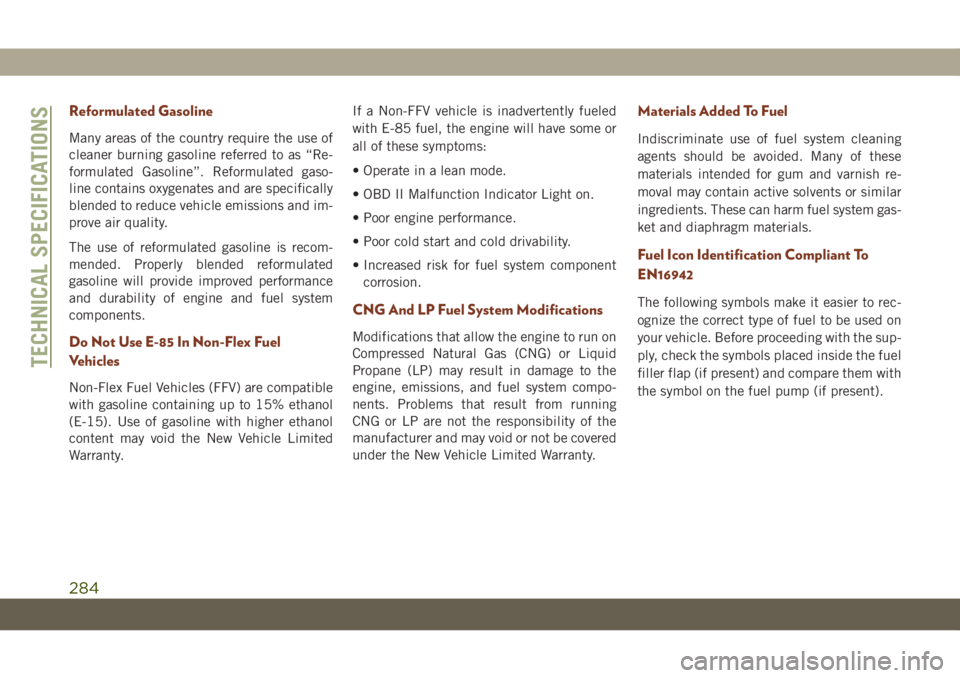
Reformulated Gasoline
Many areas of the country require the use of
cleaner burning gasoline referred to as “Re-
formulated Gasoline”. Reformulated gaso-
line contains oxygenates and are specifically
blended to reduce vehicle emissions and im-
prove air quality.
The use of reformulated gasoline is recom-
mended. Properly blended reformulated
gasoline will provide improved performance
and durability of engine and fuel system
components.
Do Not Use E-85 In Non-Flex Fuel
Vehicles
Non-Flex Fuel Vehicles (FFV) are compatible
with gasoline containing up to 15% ethanol
(E-15). Use of gasoline with higher ethanol
content may void the New Vehicle Limited
Warranty.If a Non-FFV vehicle is inadvertently fueled
with E-85 fuel, the engine will have some or
all of these symptoms:
• Operate in a lean mode.
• OBD II Malfunction Indicator Light on.
• Poor engine performance.
• Poor cold start and cold drivability.
• Increased risk for fuel system component
corrosion.
CNG And LP Fuel System Modifications
Modifications that allow the engine to run on
Compressed Natural Gas (CNG) or Liquid
Propane (LP) may result in damage to the
engine, emissions, and fuel system compo-
nents. Problems that result from running
CNG or LP are not the responsibility of the
manufacturer and may void or not be covered
under the New Vehicle Limited Warranty.
Materials Added To Fuel
Indiscriminate use of fuel system cleaning
agents should be avoided. Many of these
materials intended for gum and varnish re-
moval may contain active solvents or similar
ingredients. These can harm fuel system gas-
ket and diaphragm materials.
Fuel Icon Identification Compliant To
EN16942
The following symbols make it easier to rec-
ognize the correct type of fuel to be used on
your vehicle. Before proceeding with the sup-
ply, check the symbols placed inside the fuel
filler flap (if present) and compare them with
the symbol on the fuel pump (if present).
TECHNICAL SPECIFICATIONS
284
Page 287 of 378

Fuel IconsWhat It Means
E5Unleaded fuel containing up to 2,7 % (m/m) oxygen and a maximum ethanol content of 5,0 % (V/V)EN228compliant
fuel
E10Unleaded fuel containing up to 3,7 % (m/m) oxygen and a maximum ethanol content of 10,0 % (V/V)EN228compliant
fuel
Compressed Natural Gas and biomethane for automotive applicationsEN16723compliant fuel
Liquefied Petroleum Gas for automotive applicationsEN589compliant fuel
285
Page 288 of 378
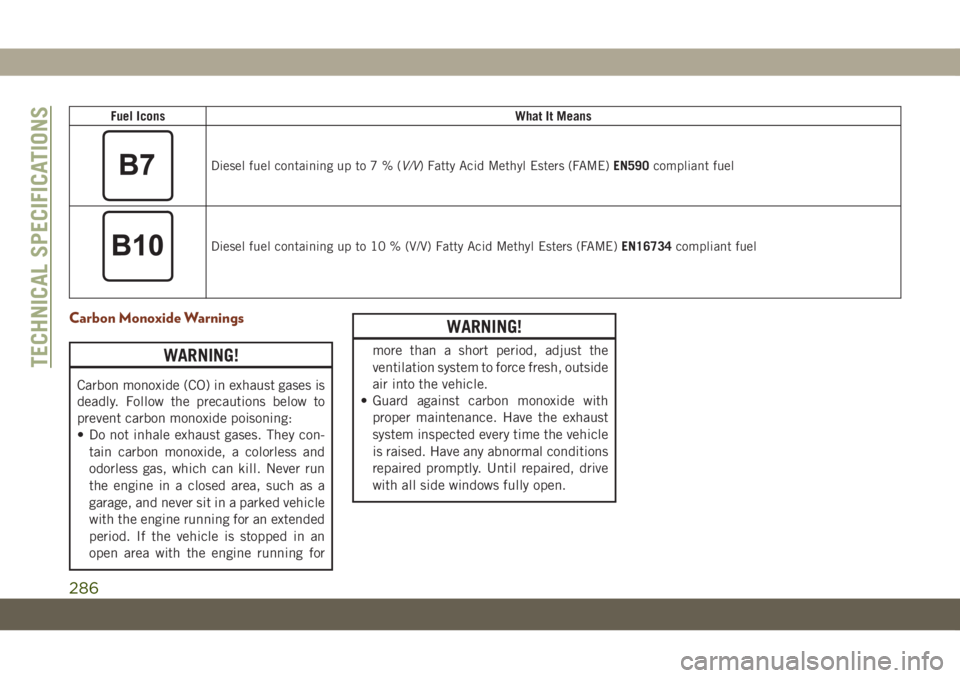
Fuel IconsWhat It Means
Diesel fuel containing up to7%(V/V) Fatty Acid Methyl Esters (FAME)EN590compliant fuel
Diesel fuel containing up to 10 % (V/V) Fatty Acid Methyl Esters (FAME)EN16734compliant fuel
Carbon Monoxide Warnings
WARNING!
Carbon monoxide (CO) in exhaust gases is
deadly. Follow the precautions below to
prevent carbon monoxide poisoning:
• Do not inhale exhaust gases. They con-
tain carbon monoxide, a colorless and
odorless gas, which can kill. Never run
the engine in a closed area, such as a
garage, and never sit in a parked vehicle
with the engine running for an extended
period. If the vehicle is stopped in an
open area with the engine running for
WARNING!
more than a short period, adjust the
ventilation system to force fresh, outside
air into the vehicle.
• Guard against carbon monoxide with
proper maintenance. Have the exhaust
system inspected every time the vehicle
is raised. Have any abnormal conditions
repaired promptly. Until repaired, drive
with all side windows fully open.TECHNICAL SPECIFICATIONS
286
Page 289 of 378
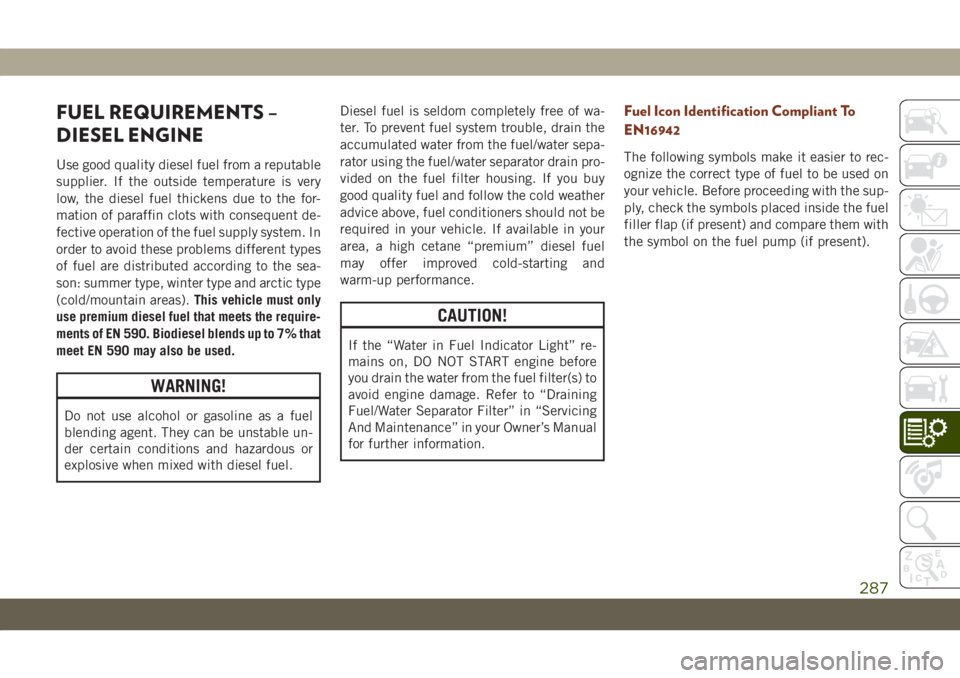
FUEL REQUIREMENTS –
DIESEL ENGINE
Use good quality diesel fuel from a reputable
supplier. If the outside temperature is very
low, the diesel fuel thickens due to the for-
mation of paraffin clots with consequent de-
fective operation of the fuel supply system. In
order to avoid these problems different types
of fuel are distributed according to the sea-
son: summer type, winter type and arctic type
(cold/mountain areas).This vehicle must only
use premium diesel fuel that meets the require-
ments of EN 590. Biodiesel blends up to 7% that
meet EN 590 may also be used.
WARNING!
Do not use alcohol or gasoline as a fuel
blending agent. They can be unstable un-
der certain conditions and hazardous or
explosive when mixed with diesel fuel.Diesel fuel is seldom completely free of wa-
ter. To prevent fuel system trouble, drain the
accumulated water from the fuel/water sepa-
rator using the fuel/water separator drain pro-
vided on the fuel filter housing. If you buy
good quality fuel and follow the cold weather
advice above, fuel conditioners should not be
required in your vehicle. If available in your
area, a high cetane “premium” diesel fuel
may offer improved cold-starting and
warm-up performance.
CAUTION!
If the “Water in Fuel Indicator Light” re-
mains on, DO NOT START engine before
you drain the water from the fuel filter(s) to
avoid engine damage. Refer to “Draining
Fuel/Water Separator Filter” in “Servicing
And Maintenance” in your Owner’s Manual
for further information.
Fuel Icon Identification Compliant To
EN16942
The following symbols make it easier to rec-
ognize the correct type of fuel to be used on
your vehicle. Before proceeding with the sup-
ply, check the symbols placed inside the fuel
filler flap (if present) and compare them with
the symbol on the fuel pump (if present).
287
Page 290 of 378
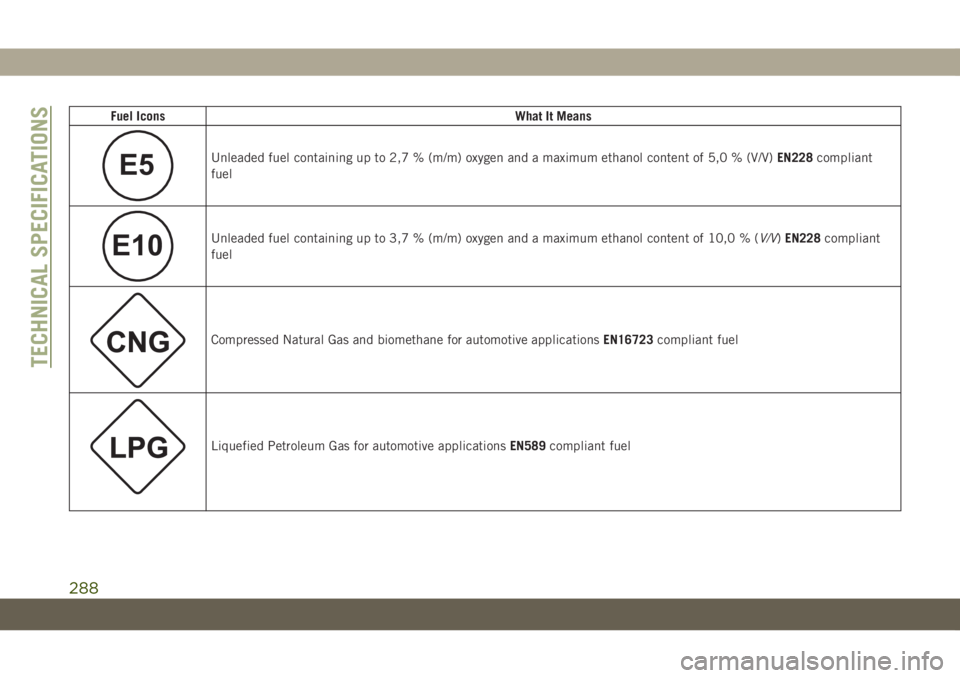
Fuel IconsWhat It Means
E5Unleaded fuel containing up to 2,7 % (m/m) oxygen and a maximum ethanol content of 5,0 % (V/V)EN228compliant
fuel
E10Unleaded fuel containing up to 3,7 % (m/m) oxygen and a maximum ethanol content of 10,0 % (V/V)EN228compliant
fuel
Compressed Natural Gas and biomethane for automotive applicationsEN16723compliant fuel
Liquefied Petroleum Gas for automotive applicationsEN589compliant fuel
TECHNICAL SPECIFICATIONS
288